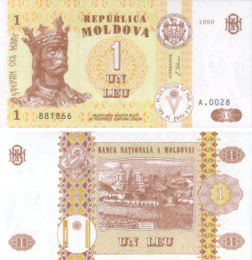- Moldovan leu
-
Moldovan leu leu moldovenesc (Moldovan) (Romanian) 
1 Leu note obverse and reverse ISO 4217 code MDL User(s)  Moldova (except Transnistria territorial unit /
Moldova (except Transnistria territorial unit /  Transnistria)
Transnistria)Inflation 7.4% Source The World Factbook, 2010 est. Subunit 1/100 ban Plural lei ban bani Coins 1, 5, 10, 25, 50 bani Banknotes 1, 5, 10, 20, 50, 100, 200, 500, 1000 lei Central bank National Bank of Moldova Website www.bnm.md The leu (ISO 4217 code MDL) is the currency of Moldova. Like the Romanian leu, the Moldovan leu (pl. lei) is subdivided into 100 bani (singular: ban). The name of the currency originates in Romania and means "lion".
Contents
History
Between 1918 and 1940 and again between 1941 and 1944, when Moldova was part of Romania, the Romanian leu was used also in the eastern part of Moldavia. The Moldovan leu was established on 29 November 1993, following the collapse of the Soviet Union and the creation of the independent republic of Moldova. It replaced the older cupon currency at a rate of 1 leu = 1000 cupon.
In Transnistria, a partially recognized state claimed in whole by Moldova, the Transnistrian ruble is used instead.
Coins
Coins consist of 1, 5, 10, and 25 bani in aluminium and 50 bani in aluminium-bronze. Aluminium 50 bani, and nickel-plated-steel 1 and 5 leu coins were issued in 1993 but have been withdrawn from circulation.
Banknotes
There have been two series of Moldovan leu banknotes. The first series was short-lived and only included 1, 5, and 10 lei.
Second Series Image Value Dimensions Main Colour Description Date of Obverse Reverse Obverse Reverse Watermark first printing issue 

1 leu 114 × 58 mm Yellow Stephen III Mănăstirea Căpriana As portrait 1994 May 1994 

5 lei Cyan Biserica sf. Dumitru din Orhei April 1994 

10 lei 121 × 61 mm Red Mănăstirea Hârjauca May 1994 

20 lei Green Cetatea Soroca 1992 November 1993 

50 lei Pink Mănăstirea Hârbovăţ May 1994 

100 lei Orange Cetatea Tighina September 1995 

200 lei 133 × 66 mm Purple Chişinău Mayoralty 

500 lei Orange and green Chişinău Cathedral December 1999 

1000 lei Blue Presidency building October 2003 For table standards, see the banknote specification table. - On the front side of each banknote only one man is represented - the best-known ruler of Moldavia - Ştefan cel Mare (Stephen the Great).
- The first two lines of the Mioriţa ballad are written in the white circle on the front side of each banknote.
- On the back side of all the banknotes there are depicted Trajan's Column and The Endless Column.
Current MDL exchange rates From Google Finance: AUD CAD CHF EUR GBP HKD JPY USD RON RUB UAH From Yahoo! Finance: AUD CAD CHF EUR GBP HKD JPY USD RON RUB UAH From OzForex: AUD CAD CHF EUR GBP HKD JPY USD RON RUB UAH From XE.com: AUD CAD CHF EUR GBP HKD JPY USD RON RUB UAH From OANDA.com: AUD CAD CHF EUR GBP HKD JPY USD RON RUB UAH See also
Preceded by:
Moldovan cupon
Reason: inflation
Ratio: 1 leu = 1000 cuponCurrency of Moldova
1993 –Succeeded by:
CurrentCurrencies of Europe European Union Eastern Belarusian ruble · Moldovan leu · Russian ruble · Transnistrian ruble (unrecognised) · Ukrainian hryvniaSouthern Western Currencies of post-Soviet states in circulation Abkhazian apsar (unrecognized) · Armenian dram · Azerbaijani manat · Belarusian ruble · Euro (Estonia) · Georgian lari · Kazakhstani tenge · Kyrgyzstani som · Latvian lats · Lithuanian litas · Moldovan leu · Nagorno-Karabakh dram (unrecognized) · Russian ruble (Russia and Abkhazia (unrecognized) and South Ossetia (unrecognized)) · Tajikistani somoni · Transnistrian ruble (unrecognized) · Turkmenistan manat · Ukrainian hryvnia · Uzbekistani somobsolete Chechen naxar (unrecognized) · Estonian kroon · Georgian kupon lari · Latvian rublis · Lithuanian talonas · Moldovan cupon · Soviet ruble · Tajikistani ruble · Ukrainian karbovanetsCategories:- Currencies of Europe
- Circulating currencies
- Economy of Moldova
Wikimedia Foundation. 2010.
